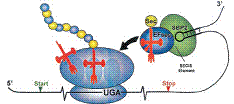Biochemistry, Department of

Vadim Gladyshev Publications
Document Type
Article
Date of this Version
April 1998
Abstract
Selenium which occurs in proteins as the amino acid, selenocysteine, is essential for numerous biological processes and for human health. A prominent 75Se-labeled protein detected in human T-cells migrated as a 15-kDa band by SDS-polyacrylamide gel electrophoresis. This protein subunit was purified and subjected to tryptic digestion and peptide sequence analyses. Sequences of tryptic peptides derived from the protein corresponded to a human placental gene sequence containing an open reading frame of 162 residues and a readthrough in-frame TGA codon. Three different peptide sequences of the 15-kDa protein corresponded to a nucleotide sequence located downstream of this codon, suggesting that the T-cell 15-kDa selenoprotein contains a selenocysteine residue encoded by TGA. Post-translational processing of the N-terminal portion of the predicted gene product to give the 15-kDa protein was suggested on the basis of molecular mass, amino acid analysis, and immunoblot assays of the purified protein. The 3’-untranslated region (UTR) of the gene encoding the 15-kDa protein contained a sequence that is very similar to the canonical selenocysteine-inserting sequence element. Computer analysis of transcript map data bases indicated that this gene was located on human chromosome 1. Its coding sequence showed no homology to known protein-encoding genes. The 15-kDa protein gene was expressed as mRNA in a wide range of tissues, with increased levels in the thyroid, parathyroid, and prostate-derived cells as evidenced by searches of partial cDNA sequences in public data bases. Genes corresponding to the 15-kDa selenocysteinecontaining protein were found in mice and rats, while the corresponding genes in Caenorhabditis elegans and Brugia malayi contained a cysteine codon in place of TGA. The discovery of a new human selenoprotein provides an additional example of the role of selenium in mammalian systems.


Comments
Published in THE JOURNAL OF BIOLOGICAL CHEMISTRY, Vol. 273, No. 15, Issue of April 10, pp. 8910–8915, 1998.